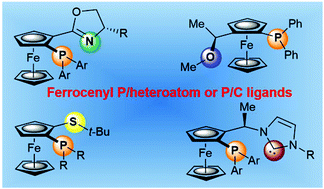Ferrocene phosphane-heteroatom/carbon bidentate ligands in asymmetric catalysis
Abstract
Chiral ferrocene derivatives belong to privileged ligand classes for asymmetric transition metal catalysed reactions. Hetero-bidentate phosphane ligands are hybrid ligands, which combine the properties of phosphorus with those of other donor atoms. This feature creates further asymmetry around the metal centre, which may be helpful for increasing the stereoinduction. Therefore, hetero-bidentate ligands are useful alternatives to homo-bidentate ligands. Ligands featuring phosphorus and nitrogen or sulphur are quite common. From among ferrocene catalysts, ferrocenyl amino phosphanes and phosphane oxazolines serve as excellent examples. Fesulphos and ThioClickFerrophos are notable P,S-ligand examples. On the other hand, combinations of phosphorus with oxygen or carbon are only beginning to show their potential in asymmetric catalysis. Another useful feature in ligands of this type is the markedly different coordination properties of donor atoms, resulting in interesting opportunities for catalysis. Ferrocenyl MOP-analogues or a fascinating combination of phosphane and secondary phosphane-oxide would represent this ligand class. The last section of the review focuses on phosphanes combined with carbon-based donor atoms that are phosphane-alkene and phosphane-carbene ligands. This review focuses on the applications of these hetero-bidentate ferrocene ligands in asymmetric catalysis with a special emphasis on the most recent and influential literature reports.


 Please wait while we load your content...
Please wait while we load your content...